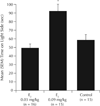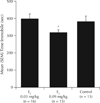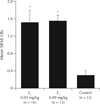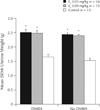Effects of two estradiol regimens on anxiety and depressive behaviors and trophic effects in peripheral tissues in a rodent model
- PMID: 19467526
- PMCID: PMC3616371
- DOI: 10.1016/j.genm.2009.04.004
Effects of two estradiol regimens on anxiety and depressive behaviors and trophic effects in peripheral tissues in a rodent model
Abstract
Background: With aging and menopause, which are associated with decreases in ovarian steroids such as 17beta-estradiol (E(2)), women might experience negative psychological symptoms, including anxiety and depression. Some women use E(2)-based therapies to alleviate these symptoms, but E(2) has been associated with trophic effects that might increase vulnerability to some steroid-sensitive cancers, such as breast cancer, in both premenopausal and postmenopausal women.
Objective: This study investigated the relationships between the possible beneficial effects of E(2) on anxiety and depressive behaviors concurrent with trophic effects using an animal model of E(2) decline and replacement.
Methods: Dose-dependent effects of E(2) on affective, sexual, and motor behavior of young adult rats were studied. Ovariectomized (OVX) rats were administered the chemical carcinogen 7,12-dimethylbenz(a) anthracene (DMBA) 1.25 mg or inactive vehicle (vegetable oil; control) by gavage. E(2) (0.03 or 0.09 mg/kg) or vehicle was administered subcutaneously 44 to 48 hours before assessments of anxiety (light-dark transition), depression (forced swim test), sexual (lordosis), and motor (activity monitor) behaviors. Fourteen weeks after carcinogen exposure, E(2) concentrations in plasma and brain regions (cortex, hippocampus, and hypothalamus) were determined. Incidences and numbers of tumors and uterine weight were analyzed.
Results: Administration of E(2) (0.09 mg/kg) was associated with significant increases in antianxiety-like behavior in the light-dark transition task, antidepressant-like behavior in the forced swim test, and physiologic circulating and central E(2) concentrations compared with E(2) (0.03 mg/kg) and vehicle. Compared with vehicle, E(2) (0.9 > 0.3 mg/kg) was associated with significant increases in lordosis and uterine weight. Administration of DMBA was associated with significant increases in the incidences and numbers of tumors; this effect was augmented by E(2)administration.
Conclusions: Based on the findings in this rat model, the hypothesis that E(2) may be effective in reducing anxiety and depressive behaviors and enhance sexual behavior in OVX rats, concurrent with trophic effects in the periphery, was supported. Moderate physiologic levels of E(2) might have beneficial effects on affective and sexual behaviors in female rodents, but regimens including E(2) might increase tumorigenic capacity.
Figures





Similar articles
-
Raloxifene and/or estradiol decrease anxiety-like and depressive-like behavior, whereas only estradiol increases carcinogen-induced tumorigenesis and uterine proliferation among ovariectomized rats.Behav Pharmacol. 2010 May;21(3):231-40. doi: 10.1097/fbp.0b013e32833a5cb0. Behav Pharmacol. 2010. PMID: 20480545 Free PMC article.
-
Estradiol reduces anxiety- and depression-like behavior of aged female mice.Physiol Behav. 2010 Feb 9;99(2):169-74. doi: 10.1016/j.physbeh.2009.09.017. Epub 2009 Oct 3. Physiol Behav. 2010. PMID: 19804793 Free PMC article.
-
Chronic estradiol replacement to aged female rats reduces anxiety-like and depression-like behavior and enhances cognitive performance.Psychoneuroendocrinology. 2009 Jul;34(6):909-16. doi: 10.1016/j.psyneuen.2009.01.004. Epub 2009 Feb 11. Psychoneuroendocrinology. 2009. PMID: 19216030 Free PMC article.
-
A review and update of mechanisms of estrogen in the hippocampus and amygdala for anxiety and depression behavior.Neuropsychopharmacology. 2006 Jun;31(6):1097-111. doi: 10.1038/sj.npp.1301067. Neuropsychopharmacology. 2006. PMID: 16554740 Free PMC article. Review.
-
Differential effects of chronic 17β-oestradiol treatment on rat behaviours relevant to depression.J Neuroendocrinol. 2018 Nov;30(11):e12652. doi: 10.1111/jne.12652. Epub 2018 Nov 13. J Neuroendocrinol. 2018. PMID: 30311279 Review.
Cited by
-
Raloxifene and/or estradiol decrease anxiety-like and depressive-like behavior, whereas only estradiol increases carcinogen-induced tumorigenesis and uterine proliferation among ovariectomized rats.Behav Pharmacol. 2010 May;21(3):231-40. doi: 10.1097/fbp.0b013e32833a5cb0. Behav Pharmacol. 2010. PMID: 20480545 Free PMC article.
-
Neurobiological mechanisms underlying sex-related differences in stress-related disorders: Effects of neuroactive steroids on the hippocampus.Front Neuroendocrinol. 2019 Oct;55:100796. doi: 10.1016/j.yfrne.2019.100796. Epub 2019 Sep 30. Front Neuroendocrinol. 2019. PMID: 31580837 Free PMC article. Review.
-
Chronic exercise prevents repeated restraint stress-provoked enhancement of immobility in forced swimming test in ovariectomized mice.Metab Brain Dis. 2015 Jun;30(3):711-8. doi: 10.1007/s11011-014-9624-2. Epub 2014 Oct 26. Metab Brain Dis. 2015. PMID: 25344674
-
Gender Differences in the Neurobiology of Anxiety: Focus on Adult Hippocampal Neurogenesis.Neural Plast. 2016;2016:5026713. doi: 10.1155/2016/5026713. Epub 2016 Jan 14. Neural Plast. 2016. PMID: 26885403 Free PMC article. Review.
-
Estrogen action: a historic perspective on the implications of considering alternative approaches.Physiol Behav. 2010 Feb 9;99(2):151-62. doi: 10.1016/j.physbeh.2009.08.013. Epub 2009 Sep 6. Physiol Behav. 2010. PMID: 19737574 Free PMC article. Review.
References
-
- Miniño AM, Heron MP, Murphy SL, et al. for the Centers for Disease Control and Prevention National Center for Health Statistics National Vital Statistics System. Deaths: Final data for 2004. Natl Vital Stat Rep. 2007;55:1–119. - PubMed
-
- Henriques A, Dickson N. Menopause: The Woman’s View. 2nd rev ed. London, United Kingdom: Quartet Books Ltd; 1992.
-
- Rossouw JE, Anderson GL, Prentice RL, et al. for the Writing Group for the Women’s Health Initiative Investigators. Risks and benefits of estrogen plus progestin in healthy postmenopausal women: Principal results from the Women’s Health Initiative randomized controlled trial. JAMA. 2002;288:321–333. - PubMed
-
- Sherwin BB. The critical period hypothesis: Can it explain discrepancies in the oestrogen-cognition literature? J Neuroendocrinol. 2007;19:77–81. - PubMed
Publication types
MeSH terms
Substances
Grants and funding
LinkOut - more resources
Full Text Sources
Medical

